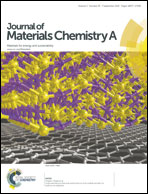Na3.12Fe2.44(P2O7)2/multi-walled carbon nanotube composite as a cathode material for sodium-ion batteries†
Abstract
Na3.12Fe2.44(P2O7)2/multi-walled carbon nanotube (MWCNT) composite was fabricated by a solid state reaction and was further used to fabricate a cathode for sodium-ion batteries. The electrochemical behaviors were thoroughly investigated in assembled non-aqueous Na3.12Fe2.44(P2O7)2/MWCNT//Na cells, showing higher specific capacity (over 100 mA h g−1 at a rate of 0.15C) and better stable cycle performance than those of the pristine Na3.12Fe2.44(P2O7)2-based one. It is noted that with increased charge–discharge cycles, the specific capacity of Na3.12Fe2.44(P2O7)2/MWCNT gets close to the theoretical capacity (ca. 117.4 mA h g−1). These good performances could be attributed to the incorporated MWCNTs, which improve the conductivity for lower charge transfer resistance and shorten the diffusion length for faster Na+ diffusion to access the reaction sites. Through systematic studies of EIS at different states of charge and discharge, it is discovered that Rct decreases with the increase of voltage and reaches a minimum value at redox sites, but Re and DNa+ show the opposite trend. Moreover, a full cell test using a carbon black negative electrode also demonstrates good capacity retention up to 50 cycles and a reversible capacity of 145 mA h g−1 with the average operation voltage of 2.8 V.


 Please wait while we load your content...
Please wait while we load your content...